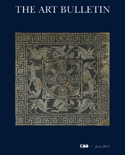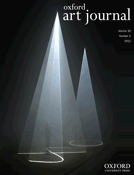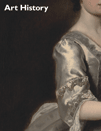
Art & Perception
Scope & Guideline
Advancing Understanding of Visual Arts and Psychology
Introduction
Aims and Scopes
- Interdisciplinary Research on Art Perception:
The journal emphasizes studies that integrate insights from psychology, neuroscience, and art theory to examine how individuals perceive and interpret visual art. - Empirical Methodologies:
It supports empirical research, including experimental designs, eye-tracking studies, and qualitative analyses, to provide evidence-based insights into the aesthetic experience. - Cognitive and Emotional Responses to Art:
Research exploring how art elicits emotional and cognitive responses is a core focus, contributing to our understanding of the psychological impact of visual stimuli. - Cultural Contexts and Art:
The journal also addresses the role of cultural and historical contexts in shaping art perception, highlighting the significance of diverse artistic traditions. - Innovative Approaches to Visual Analysis:
It encourages innovative methodologies for visual analysis, including the use of technology in art history and contemporary art practices.
Trending and Emerging
- Perception and Technology in Art:
There is an increasing focus on how technology, including digital art and new media, influences perception. This includes studies on eye-tracking in digital artworks and the impact of interactive installations. - Affective and Emotional Engagement with Art:
Recent publications emphasize the emotional engagement of viewers with art, exploring how different artistic elements evoke emotional responses, which is crucial for understanding viewer experience. - Interdisciplinary Approaches to Aesthetics:
Emerging themes reflect a blending of disciplines, with studies integrating cognitive science, philosophy, and art theory to create a more holistic understanding of perception. - Ecological and Environmental Art Perspectives:
There is a growing interest in how ecological themes and environmental contexts shape artistic expression and viewer perception, indicating a potential shift in the thematic focus of visual arts. - Cultural and Social Impacts on Art Perception:
Recent articles examine how cultural backgrounds and social contexts influence the perception and appreciation of art, highlighting the importance of diversity in art interpretation.
Declining or Waning
- Traditional Art Historical Analysis:
There seems to be a waning interest in purely traditional art historical analyses without empirical support, as the journal increasingly favors studies that incorporate psychological and perceptual frameworks. - Static Representations of Art:
Research focusing solely on static representations of art, such as traditional still life or portraiture, is becoming less frequent, likely due to a growing interest in dynamic and interactive forms of art. - Single-Disciplinary Approaches:
Papers that rely on a single disciplinary perspective, such as purely aesthetic or philosophical discussions without empirical backing, are less common, as the journal trends towards interdisciplinary studies.
Similar Journals

OUD HOLLAND is a prestigious journal published by BRILL, focusing on the rich history and developments in the visual arts and performing arts. With a historical lineage dating back to its initial publication years from 1883 and periodic revivals until 2024, this journal has maintained its relevance amidst evolving artistic discourse. It holds an impressive standing in the Arts and Humanities field, ranking 338 out of 667 in the Visual Arts and Performing Arts category, positioning it comfortably within the 49th percentile. The journal disseminates critical research and insightful articles that cater to scholars, professionals, and students dedicated to advancing their understanding of artistic heritage and contemporary methodologies. Though currently not open access, OUD HOLLAND represents an invaluable resource for those committed to exploring the multifaceted dimensions of art, offering access to a wealth of knowledge grounded in meticulous research and scholarship.

STORIA DELL ARTE
Unveiling Artistic Narratives Across ErasSTORIA DELL ARTE is a notable journal dedicated to the rich exploration of art history and its varied facets, published by LUCA EDITORI ARTE ROMA. With an ISSN of 0392-4513, this publication serves as a vital resource for researchers, professionals, and students in the fields of Visual Arts and Performing Arts. Although the journal's coverage in Scopus has been discontinued from 2014, it has been recognized in the Scopus ranking as positioned within the 31st percentile among 374 entries in its category, highlighting its relevance in the realm of arts and humanities. While it does not offer open access, the journal's commitment to enriching the discourse on art history makes it an essential read for anyone interested in visual culture and historical contexts. Based in the heart of Rome, at VIA NOVELLA, 22, ROMA 00199 RM, ITALY, STORIA DELL ARTE continues to inspire scholarly discussion and contribute valuable insights to the academic community.

Empirical Studies of the Arts
Pioneering Interdisciplinary Research in Literature, Music, and Visual ArtsEmpirical Studies of the Arts is a prominent academic journal published by SAGE Publications Inc, specializing in the interdisciplinary fields of Literature, Music, and Visual Arts and Performing Arts. With an impressive Q1 ranking in multiple categories for 2023, this journal serves as a crucial platform for scholars, researchers, and practitioners engaged in the empirical exploration of arts and their influence on society. Established to foster rigorous inquiry, the journal features peer-reviewed articles that delve into both qualitative and quantitative research methodologies. This commitment to maintaining a high academic standard is evident in its Scopus rankings, which place it in the 99th percentile in Literature, 96th percentile in Visual Arts, and 92nd percentile in Music, making it a vital resource for those seeking to enrich their understanding of arts-related phenomena. While the journal does not currently offer open access options, it remains dedicated to advancing knowledge through comprehensive research, contributing significantly to the ongoing discourse in the arts.

APERTURE
Advancing Scholarship in the World of ArtAPERTURE is an esteemed journal that has captivated the attention of professionals, researchers, and students in the fields of visual arts and performing arts since its inception. Published in the United States by APERTURE, this journal offers a unique platform for interdisciplinary dialogue and exploration, seeking to promote critical discussions around contemporary and historical art practices. Although it operates under a subscription model, APERTURE maintains a commitment to enriching the artistic community, as evidenced by its focus on high-quality content. With a 2023 Scopus rank placing it in the 2nd percentile for visual arts and performing arts, it is regarded as a niche publication aimed at fostering innovative ideas and discourse, even within a competitive landscape. The journal's influence is reflected in its category quartile of Q4, suggesting that it serves as a vital resource for emerging voices in the arts. As it continues to bridge past and present artistic narratives, APERTURE remains an important reference point for ongoing scholarship and practice in visual arts.

Religion and the Arts
Illuminating the Harmony Between Spirituality and the ArtsReligion and the Arts is a distinguished scholarly journal published by BRILL, based in the Netherlands, with a dedicated focus on the interdisciplinary exploration of religion and its interplay with various artistic expressions from historical and contemporary perspectives. Established in 1996, this journal serves as a vital platform for researchers, professionals, and students interested in Cultural Studies, History, Religious Studies, and the Visual and Performing Arts. Despite its current classification in the Q4 category across multiple fields, it remains committed to advancing academic discourse and fostering innovative approaches to understanding the complex relationships between spirituality and artistic creation. With its ISSN 1079-9265 and E-ISSN 1568-5292, the journal invites submissions that contribute to enriching this dynamic field, ensuring that a diverse range of voices and perspectives are represented. Although not an Open Access publication, the journal’s content continues to be pivotal for scholarly engagement and is essential reading for those dedicated to the study of art's profound connections with religious traditions.

ART BULLETIN
Navigating the Depths of Cultural History and Visual ArtsART BULLETIN is a prestigious journal dedicated to the fields of history and visual arts, published by Routledge Journals, Taylor & Francis Ltd. With a rich publication history dating back to 1945, this journal serves as a vital platform for scholarly discourse, presenting cutting-edge research and critical analyses that contribute to our understanding of the arts across various contexts. Despite its Q3 ranking in both the History and Visual Arts categories, the journal has managed to achieve notable stature among its peers, evidenced by its Scopus ranking, placing it in the top 20% for Visual Arts and in the top 25% for History. Scholars and students alike will find valuable insights and innovative perspectives within its pages, making it an essential resource for anyone invested in the academic exploration of art and cultural history. Although currently not open access, the journal is committed to fostering an informed community by disseminating works that encourage scholarly engagement and creative thought.

OXFORD ART JOURNAL
Illuminating the Intersection of History and ArtOxford Art Journal, published by Oxford University Press, serves as a vital platform for scholarly discourse in the fields of History, Visual Arts, and Performing Arts. With an ISSN of 0142-6540 and an E-ISSN of 1741-7287, this esteemed journal has cultivated a rich academic presence since its inception, reflecting a deep commitment to exploring the intricacies of art history and contemporary visual culture. Holding a Q2 ranking in Visual Arts and Performing Arts and a Q3 ranking in History for the year 2023, the journal features rigorous peer-reviewed articles that push the boundaries of research and offer new insights into artistic practices. Although not offering open access, the journal is widely respected for its contributions to the academic community, making it invaluable for researchers, professionals, and students deeply engaged in art studies. For those seeking a comprehensive understanding of the visual arts landscape, the Oxford Art Journal remains an indispensable resource.

ART HISTORY
Exploring the Rich Tapestry of Art Across Time and CultureART HISTORY is a prestigious journal published by Wiley, focusing on the dynamic and diverse field of visual arts and performing arts since its inception in 1978. With an ISSN of 0141-6790 and an E-ISSN of 1467-8365, the journal has established itself as a significant resource for researchers, professionals, and students interested in exploring the complexities of art across various epochs and cultures. Currently ranked in the Q3 category within the Visual Arts and Performing Arts sector and positioned at #132 out of 667 in Scopus rankings—representing the top 80th percentile—ART HISTORY delivers insightful scholarship that contributes to the understanding and appreciation of art history. Although it does not offer open access, the journal remains committed to publishing high-quality, peer-reviewed articles that delve into critical artistic practices, theories, and aesthetics. The journal's location in the United Kingdom further enhances its international reach and influence, making it a vital platform for advancing discourse in the arts.

Taida Journal of Art History
Bridging theory and practice in the realm of art history.Taida Journal of Art History, published by NATIONAL TAIWAN UNIVERSITY, GRADUATE INSTITUTE OF ART, is a pioneering academic journal dedicated to the exploration and critique of art history, particularly within the unique cultural context of Taiwan. Since its inception in 2018, the journal has become an important platform for scholarly discourse, offering insights into the evolution of visual arts and performing arts, alongside comprehensive studies in history. With an ISSN of 1023-2095, it currently ranks within the Q4 category in Arts and Humanities (Miscellaneous) and the Q3 category in History and Visual Arts and Performing Arts, indicating its growing influence in these fields. Researchers, professionals, and students alike can benefit from its rigorous peer-reviewed articles that bridge theoretical frameworks with practical applications, making it an essential resource for those engaged in the arts and humanities. This commitment to fostering academic excellence is reflected in its Scopus rankings, where it stands at Rank #338/667 in Visual Arts and Performing Arts and Rank #1027/1760 in History. Engage with the Taida Journal of Art History to gain deeper insights into the evolving narratives of artistic expression.

PsyArt Journal-Online Journal for the Psychological Study of the Arts
Advancing Understanding: The Psychological Dimensions of Artistic ExpressionPsyArt Journal is a leading online journal dedicated to the psychological study of the arts, published by the PSYART FOUNDATION. With an E-ISSN of 1088-5870, this journal provides a dynamic platform for researchers, professionals, and students to explore the intricate connections between psychology and various art forms. While specific metrics such as impact factor and h-index are not disclosed, its commitment to advancing the understanding of artistic expression through psychological lenses is unparalleled. PsyArt Journal embraces an open-access approach, allowing for wide dissemination of research and fostering a collaborative academic environment. The journal covers a broad scope including, but not limited to, visual arts, music, literature, and performance, providing valuable insights into how art influences mental processes and vice versa. Situated in the vibrant academic landscape of Cambridge, MA, PsyArt Journal continues to attract a diverse range of scholarly articles, reviews, and theoretical discussions, making it an essential resource for anyone invested in the intersection of psychology and the arts.